Fix: There is Insufficient Memory or Disk Space in Word
Several users are encountering the ‘There is Insufficient Memory or Disk Space’ error immediately after opening Word or Excel. Most affected users are reporting that the issue is occurring with any type of documents. The issue is confirmed to appear with Office 2010, Office 2013 and Office 2016.

What is causing the ‘There is insufficient memory or disk space’ Error in Microsoft Word?
We looked into this particular error by investigating various user reports and the repair strategies that are commonly used to resolve this issue. Based on what we gathered, there are several common culprits that are known to trigger this particular error:
- Corrupted Normal.dotm file – A corrupted Normal.dotm file is known to trigger this particular error message. This error will typically get thrown in Word in those cases where the default font styles can’t be loaded. In this case, you can resolve the issue by forcing Windows to create a new .dotm file.
- Broken Office Installation – An incomplete or a crippled installation (as a result of an AV scan) can also trigger this particular error message. If this scenario is applicable, you should be able to resolve it by repairing the Office installation via Programs and Features.
- Insufficient permissions on the font folder– Another popular scenario in which this error might appear is if the fonts folder doesn’t have the necessary permissions. In this case, you can either create a policy via Registry Editor or use a series of Powershell commands to grant the necessary permissions.
- Corrupted font cache – Corruption among your font folder might trigger this particular error if some fonts used by the file you’re trying to open are affected. In this case, you can resolve the issue by creating a .bat file capable of flushing your font cache.
- An Add-in is triggering the error – There are several Word and Excel add-ins known to facilitate the apparition of this issue. If this scenario is applicable, you will be able to resolve the issue by identifying the culprit and remove it from your add-ins list.
If you’re currently struggling to resolve the ‘There is Insufficient Memory or Disk Space’ error, this article will provide you with several troubleshooting steps. Down below, you’ll find a collection of methods that other users in a similar situation have successfully deployed to get around this error message.
For the best results, we advise you to follow them in the order that they are presented in – the potential fixes are ordered by efficiency and severity. One of them is bound to resolve the issue in your particular scenario.
Method 1: Renaming the Normal.dotm file
Several users that we’re encountering this particular issue have reported that they were able to resolve the issue permanently by navigating to Microsoft Office Template folder inside the Roaming folder and renaming the Normal.dotm file with the .old extension.
This operation will force Microsoft Word / Excel to create a new Normal.dotm file the next time the program is launch, which will end up resolving the issue.
The Normal.dotm template will open whenever you Start Microsoft Word – it includes default styles and customizations that determine the basic look of a document. A corrupted Normal.dotm template is known to trigger the ‘There is Insufficient Memory or Disk Space’ error.
Here’s a quick guide on renaming the Normal.dotm file:
- Make sure you don’t have any program belonging to Microsoft Office opened.
- Open File Explorer and navigate to the following location:
C:\Users\*YourUser*\AppData\Roaming\Microsoft\Templates
Note: If the AppData folder is not visible, go over to the Ribbon menu at the top and click on View. Then, make sure that the box associated with Hidden Items is checked. Once, Hidden Items is enabled, your Appdata folder will become visible.
- Once you reach the Templates folder, access the View tab using the ribbon at the top and make sure that the box associated with File Name Extensions is checked.
- Then, right-click on Normal.dotm and choose Rename. Next, add .old after the file’s extension and save the change. This will signal that the file is obsolete, forcing the program to create a new version of the same file the next time it needs to use it.
Note: Renaming a file with the .old extension is better than deleting it, mainly because you can always go back and delete the extension in order to make the file usable again if you need to. - Open the program that was previously showing the error and see if the issue has been resolved.

If you’re still encountering the “there is insufficient memory or disk space” error, move down to the next method below.
Method 2: Repairing the Office Installation
Based on what some affected users are saying, this particular issue can also occur if you’re dealing with a corrupted or broken installation. Before you try anything else, see if repairing the Office installation will resolve the issue and allow you to open Word / Excel files without encountering the “there is insufficient memory or disk space” error.
Here’s a quick guide on repairing your Microsoft Office installation:
- Press Windows key + R to open up a Run dialog box. Then type “appwiz.cpl” and press enter to open up the Programs and Features window.

Type appwiz.cpl and Press Enter to Open Installed Programs List - Inside the Programs and Features, locate your Microsoft Office installation, right-click on it and choose Change.
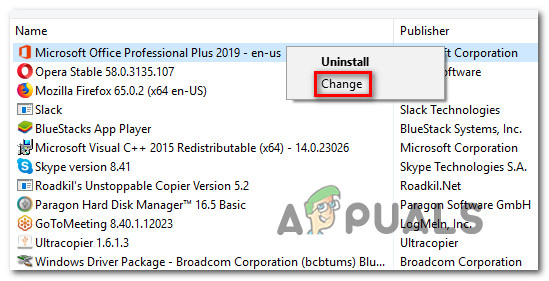
Changing the Microsoft Office installation - Select Quick Repair and hit the Repair button. At the confirmation window, click Repair again to to kickstart the installation.
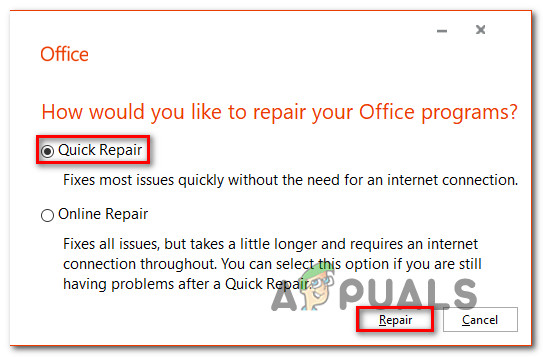
Repairing the Office Installation - Once the process is complete, restart your computer and see if the issue has been resolved at the next startup.
If you’re still encountering the same error message, move down to the next method below.
Method 3: Creating SaveZoneInformation policy via RegistryEditor
Some users have reported that they were finally able to resolve the issue after creating a policy called SaveZoneInformation using Registry Editor. After this policy was enforced, they reported being able to open .doc attachments without encountering the “there is insufficient memory or disk space” error.
Here’s a quick guide on making this registry edit in order to create the SaveZoneInformation policy:
- Press Windows key + R to open up a Run dialog box. Then, type “regedit” and press Enter to open up Registry Editor. When prompted by the UAC (User Account Control), click Yes to grant administrative privileges.
- Once you get inside the Registry Editor utility, use the left-hand pane to navigate to the following location manually:
HKEY_CURRENT_USER\Software\Microsoft\Windows\CurrentVersion\Policies
Note: You can either navigate there manually or simply paste the location inside the navigation bar and hitting Enter.
- Once you get to that location, right-click on Policies and choose New > Key. Then, name the newly created key to Attachments.
Note: Keep in mind that it’s very important that the Attachments key is a subkey of Policies. - With the Attachments key selected, go over to the right-hand pane, right-click on an empty space and choose New > Dword (32-bit) value.
- Name the newly created Dword as SaveZoneInformation and press Enter to save the changes.
- Double-click on the newly created SaveZoneInformation and set it’s value to 1.
- Close Registry Editor and open program that was previously showing you the error to see if the issue has been resolved.

If you’re still encountering the “there is insufficient memory or disk space” error, move down to the next method below.
Method 4: Removing Word / Excel Add-ins
As some several affected users have pointed out, this particular issue can also occur in those instances where a Word or Excel add-in is causing the “there is insufficient memory or disk space” error. If this scenario is applicable, you’ll only be able to resolve the issue by identifying the add-in responsible and dealing with it.
Note: On Word, the add-in that is mostly reported to cause this particular issue is Instant Messaging Contacts.
Keep in mind that the steps of disabling an add-in are exactly the same on both Word or Excel, so feel free to follow the guide below regardless of the program that you’re encountering the error with:
- Open the program that is showing the error (Word or Excel), but don’t try opening a file. Simply double-click on the main executable and go to File > Options.
- In Excel Options / Word Options, select Add-ins from the left-hand side. Then, move over to the right-hand side pane.
- Scroll down to the bottom of the Add-ins screen, select Excel / Word Add-ins (near Manage) and click the Go button.
- Inside the Add-ins screen, uncheck the box associated with every Add-in until each one is disabled. then hit the OK button.
- Repeat step 2 to return to the Add-ins menu.
- This time, select COM Add-ins from the Manage button and click the Go button again.
- Uncheck every box associated with an Add-in and click the Ok button again to ensure that every add-in is enabled.
- Restart the program (Word / Excel) and try opening a file that was previously triggering the error message.
- If you’re no longer encountering the error, systematically re-enable each disabled add-in (one by one) until you get the error again. You should eventually be able to pinpoint the issue that is causing the error message.
- Once you manage to identify the Add-in responsible for the error message, return to the Add-in menu, select it and click Remove to get rid of it.
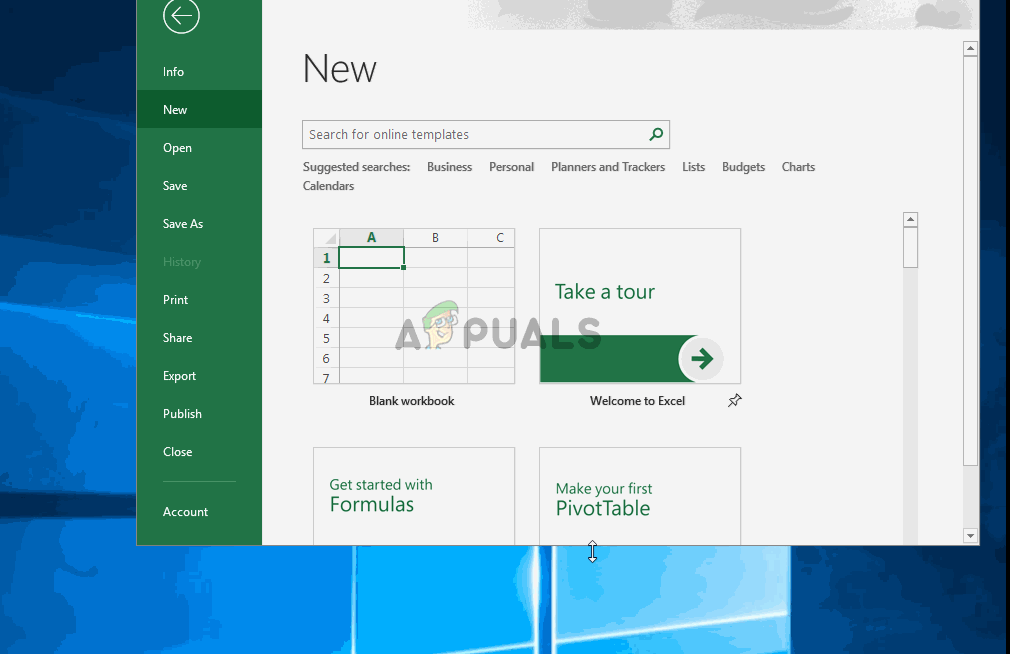
Method 5: Establishing the necessary permissions
As it turns out, this issue can also occur if the C:\windows\fonts folder doesn’t have the necessary permissions to access and edit the fonts used by Microsoft programs such as Word and Excel. This is a known bug that is mainly reported to occur with Windows 10 Creators Update builds.
If this scenario is applicable to your current situation, you can resolve it by running a series of command in an elevated PowerShell window.
Here’s what you need to do:
- Press Windows key + R to open up a new Run dialog box. Then, type “powershell” and press Ctrl + Shift + Enter to open up an elevated Powershell Window. When prompted by the UAC (User Account Control), click Yes grant administrative privileges.

Run dialog: powershell Then press Ctrl + Shift + Enter - Inside the elevated Powershell window, type/paste the following commands in order and press Enter after each one to resolve the issue:
Get-acl C:\Windows\fonts\arial.ttf | Set-Acl -path c:\windows\fonts\*.* Get-acl C:\Windows\fonts\arial.ttf | Set-Acl -path c:\windows\fonts
- After the two commands have been successfully processed, restart your computer and see if the issue is resolved at the next startup.
If you’re still encountering the “there is insufficient memory or disk space” error, move down to the next method below.
Method 6: Rebuilding the Font Cache on Windows 10
Some users that have been encountering the with Word documents from a SharePoint site synched with Onedrive reported that the issue was only resolved after flushing the font cache and rebooting the machine.
The font cache is a set of files used by Windows to manage and display the fonts currently installed on the PC. Corruption might case some fonts to malfunction, which will end up triggering the “there is insufficient memory or disk space” error when a program like Word or Excel is trying to use them.
Fortunately, you can resolve this quite easily by creating and running a .bat file capable of rebuilding your font cache on Windows 10. Here’s what you need to do:
- Press Windows key + R to open up a Run dialog box. Then, type “notepad” and press Enter to open the built-in Text Editor.

Opening Notepad via a Run dialog box - Inside the Notepad window, paste the following code:
@echo off :: Stop and disable "Windows Font Cache Service" service :FontCache sc stop "FontCache" sc config "FontCache" start=disabled sc query FontCache | findstr /I /C:"STOPPED" if not %errorlevel%==0 (goto FontCache) :: Grant access rights to current user for "%WinDir%\ServiceProfiles\LocalService" folder and contents icacls "%WinDir%\ServiceProfiles\LocalService" /grant "%UserName%":F /C /T /Q :: Delete font cache del /A /F /Q "%WinDir%\ServiceProfiles\LocalService\AppData\Local\FontCache\*FontCache*" del /A /F /Q "%WinDir%\System32\FNTCACHE.DAT" :: Enable and start "Windows Font Cache Service" service sc config "FontCache" start=auto sc start "FontCache"
- Go to File > Save as and name it whatever you want, but make sure that you save it with the .bat extension.
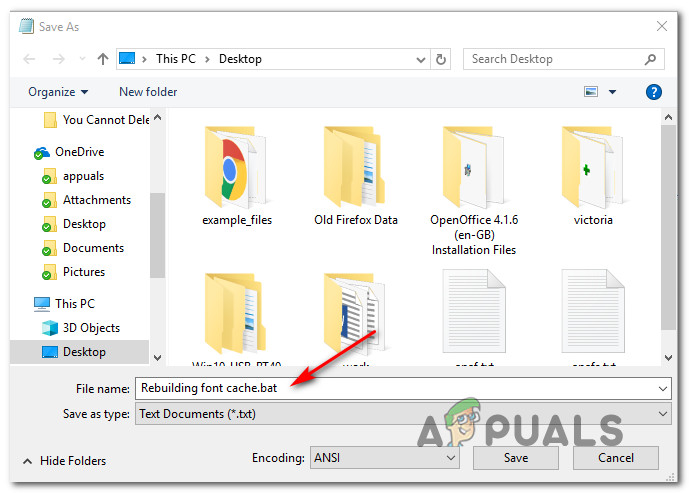
Creating the .bat file - Right-click on the newly created .bat file and choose Run as administrator to run it.
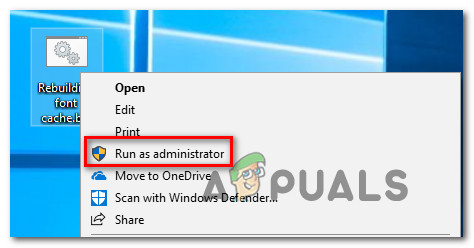
Rebuilding the font cache via .bat file - Once the operation is complete, restart your computer and see if the issue has been resolved.




